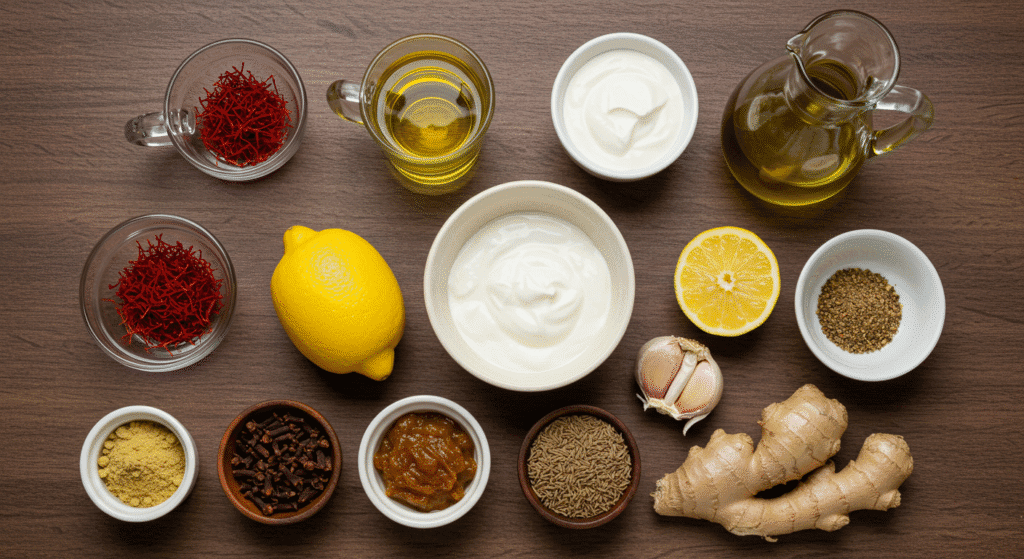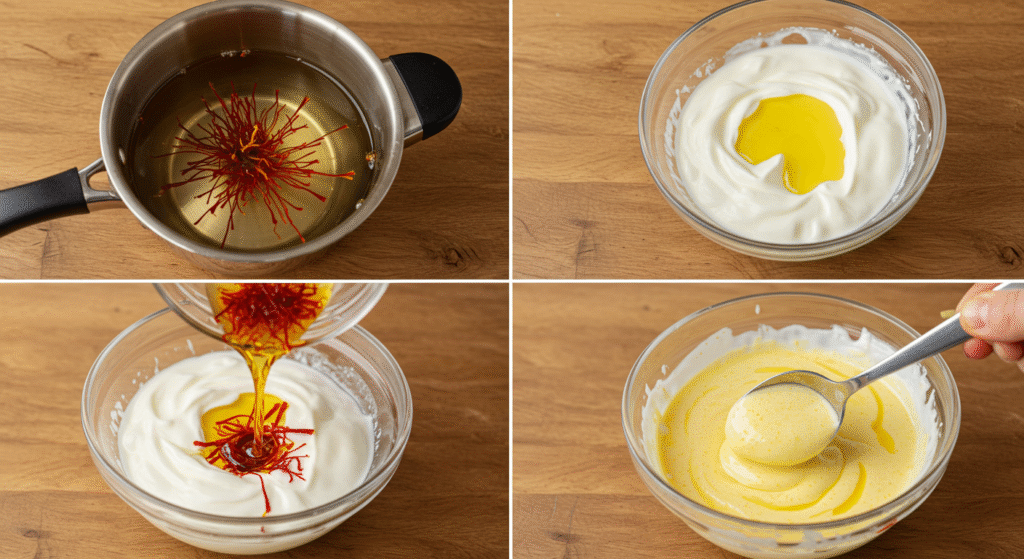Moroccan Saffron Sauce: A Golden Touch of Flavor and Heritage
Saffron sauce isn’t just a drizzle — it’s a declaration. In Morocco, saffron isn’t an ingredient you use casually. It’s treasured. Protected. Sometimes even whispered about like a family secret. This golden spice, hand-harvested in the rugged beauty of Taliouine, transforms anything it touches — from fish to lamb, from couscous to dips — into something memorable.
But let’s be honest: most saffron sauces out there don’t do it justice. They dilute its story, its soul. This recipe changes that.
Whether you’re craving a creamy saffron dip for warm khobz or a silky finish to your Friday tagine, this Moroccan saffron sauce recipe delivers depth, richness, and warmth — just like a good Moroccan meal should. We’ll walk you through exactly how to coax out saffron’s floral flavor, when to use yogurt versus cream, and why a Moroccan version stands out from anything you’ve tried before.
Let’s unlock the essence of saffron — the real way.
Table of Contents
Recipe Details
- Prep Time: 10 minutes
- Cook Time: 0–5 minutes (if served warm)
- Total Time: 10–15 minutes
- Servings: 6–8
- Calories per Serving: ~95 kcal
Saffron Sauce Ingredients for Authentic Moroccan Flavor

To create this deeply aromatic, golden-hued sauce, you’ll need just a few quality ingredients — but each one matters. Here’s what to gather:
Basic Version (Creamy & Versatile)
- A small pinch of high-quality saffron threads (preferably from Taliouine, Morocco)
- 3 tablespoons hot water
- ¾ cup Greek yogurt or heavy cream (for a richer version)
- 1 small garlic clove, finely grated or crushed
- 2 tablespoons fresh lemon juice
- 3 tablespoons extra virgin olive oil
- Coarse sea salt, to taste
Optional Moroccan Touches:
- ½ teaspoon smen (fermented butter) for depth
- ¼ teaspoon preserved lemon paste for tangy complexity
- A pinch of ground cumin or ginger (if pairing with tagine or lamb)
Note: Always bloom the saffron in hot water first. It’s not optional — it’s sacred.
Preserved Lemon Use in Moroccan Cuisine
Saffron Sauce Preparation – Step-by-Step Guide

This sauce is all about layering flavor gently. Don’t rush it. Think of it like brewing tea — only the tea is liquid gold.
Step 1: Bloom the Saffron
- In a small bowl, add the saffron threads to the hot water.
- Let it sit for at least 5–10 minutes. The water should turn a deep amber hue.
Pro Tip: Cover the bowl with a saucer to trap the aroma while blooming.
Step 2: Build the Base
- In a separate bowl, whisk together the Greek yogurt (or cream), grated garlic, and lemon juice.
- Mix until smooth and fully emulsified.
Step 3: Add the Infused Saffron
- Slowly stir in the saffron infusion — threads and all.
- Watch the color shift to golden-yellow. Breathe it in.
Step 4: Finish with Olive Oil and Salt
- Whisk in the olive oil gradually, then season with sea salt to taste.
- For extra richness, fold in a touch of smen or preserved lemon, if using.
Step 5: Chill or Serve Warm
- For a dipping sauce, chill for 20–30 minutes.
- For a warm drizzle (e.g., over grilled chicken or fish), heat gently without boiling.
Saffron Sauce Tips & Tricks for Perfect Flavor
You’ve got the basics — now here’s how to level up. A little attention to detail makes this sauce unforgettable.
Don’t Skip the Bloom
Saffron isn’t garlic or parsley — you can’t just toss it in. Blooming it in hot (not boiling) water releases its essential oils and lets the earthy-floral aroma develop properly.
Choose the Right Dairy
- Greek yogurt gives tang and creaminess.
- Heavy cream makes it luxurious.
- For a Moroccan twist, try labneh or smen.
Balance the Acidity
Lemon is crucial for brightness, but go slow. Some Moroccan cooks even use vinegar or preserved lemon.
Serve It Right
- Cold: with bread, veggies, or as mezze.
- Warm: over lamb, chicken, or roasted veg.
Amazon: Saffron Origin & Quality
Moroccan Saffron Sauce Substitutions & Variations
Every kitchen is different — and sometimes you just don’t have smen or Greek yogurt. Here’s how to keep the flavor alive:
Dairy Swaps
- Use labneh, crème fraîche, or strained regular yogurt.
- For vegan: coconut yogurt or cashew cream.
Tang and Umami Boosters
- Try vinegar, roasted garlic, or anchovy paste.
Flavor Profiles
- Herby: Add mint or cilantro.
- Spiced: Try ras el hanout, turmeric.
- Sweet-savory: A dash of honey with seafood.
Regional Tweaks
- Essaouira: More cumin, lemon zest.
- Fez: Thick yogurt + orange blossom.
- Fusion: Lime juice + use with sushi!
Author’s suggestions
Moroccan Turkey Breast Recipe with Chermoula sauce & Saffron Sauce
Moroccan Saffron Sauce – Final Thoughts & Cultural Inspiration
Saffron sauce isn’t just a condiment — it’s a conversation starter. It carries stories of sun-drenched fields in Morocco, of hands that carefully harvest each thread, and of kitchens where flavor means heritage.
Now that you’ve got the know-how, it’s your turn to bring this golden sauce to life — whether you’re dressing up a quiet Tuesday dinner or impressing guests at your next gathering.
Tried it? Let us know in the comments how you used your Moroccan saffron sauce! Tag us @moroccanfoodie or use #MoroccanSaffronMagic to be featured.
Nutrition Information (Per Serving – Based on Yogurt Version)
| Nutrient | Amount |
|---|---|
| Calories | 95 kcal |
| Total Fat | 8 g |
| Saturated Fat | 1.5 g |
| Protein | 3.5 g |
| Carbohydrates | 2 g |
| Sugars | 1 g |
| Fiber | 0 g |
| Sodium | 120 mg |
Based on standard ingredients. Actual values may vary.
Moroccan Saffron Sauce – Frequently Asked Questions
Can I use saffron powder instead of threads?
Threads are better. Powder is often weaker and less pure.
How long does it last?
Up to 3 days in the fridge. Avoid freezing.
Can I cook it?
Yes — but only gently. Yogurt can curdle.
Is Moroccan saffron really different?
Yes. Moroccan saffron (Taliouine) is more potent.
Best pairings?
Lamb, fish, couscous, grilled veg, or as dip.
Have you tried using it in your recipes? Tell us about your experiences!
There are no reviews yet. Be the first one to write one.

